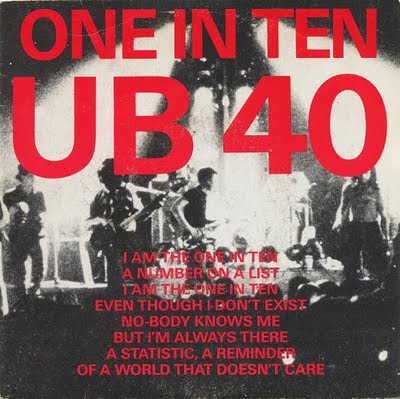Remember UB40s 1981 classic, One in Ten? Just listened to it again. What brilliant lyrics. As we approach another general election I’m not sure how relevant the statistic 1-in10 still is to all the examples they give, but the words are more relevant than ever. ‘I’m a cancer ridden spectre…’

I purposefully named this blog post after a statistic (the percentage of females who will get breast cancer at some point in their life). But I’ve commented before that teaching about social research with numbers will resonate more with me now. Listening to UB40 reminds me of my student days, and makes me incredibly angry because prospects for less-privileged young people in the UK today are no better than they were back then. Progress, what progress? Social mobility, I don’t think so. Representative democracy – really?
Getting angry is supposed to be part of the whole cancer thing. Not sure my anger is well-placed but it’s definitely there. I guess I have more time to think about things at the moment. I have to say I haven’t been angry about the cancer, though I have been reproachful of my behaviour that may have contributed.
Anyway – back to the statistics. We found out today my mother-in-law is a one-in-600 suffering from a rare, but treatable, disease. I wish her all the luck in the world in her treatment. A good friend discovered last year he had a very rare heart condition resulting in open heart surgery (is still living life to the full thankfully). I know of others though who have been very, very unlucky in their cancer stories. And of course some, a lot, who have come through it and still living life to the full. That’s statistics for you – we can look at the aggregate but behind these are always individuals.
Today I went to see the oncologist to find out about the next stage of treatment (radiotherapy and hormone medication) and learned that I’m a lucky one (ooh – that makes me think of the gorgeous Alison Krauss number, one of my favourite artists with the most sublime voice). Because of the size of my tumour, because they caught it at the screening stage, and the margins are clear and the cancer is out, and I’m going to be zapped with radiation, looks like the chance of a recurrence is small, around 1%. What a relief it was to hear that.
So today I’m feeling better. I’d been carrying around a huge load which I didn’t appreciate until Dr B (female – and yes I have to say that as I had imagined she’d be male – I’m ashamed at myself for that) told me the 1% news. My shoulders dropped about 3 inches and a ridiculous grin spread across my face. Even though I have to go and have the breast fine-needle aspirated (ouch) tomorrow (42% in my age group according to a study (N=158) suffer from this following breast-preserving surgery) I can sleep more easily tonight. And start to mentally prepare for the radiotherapy and my return to work. Hope they’re ready for me. My classes are going to be good next year.
No numbers without stories. No stories without numbers.

So pleased 😁 to hear. That you are having hormone therapy is a positive thing. You have a hormone positive cancer – yeah! Women with hormone negative have no options to lower their chance of recurrence. Not to be a downer but as a numbers girl keep an eye on the time period those percentages apply. Often the 1% is for that 5 year post diagnosis number that oncologists use as a measure of success. There are now so many 5 year successes that we all need to be looking to the 10 and 15 year recurrence rates and how to lower these.
Because we take our hormone treatment for 5 years minimum (and it has side effects like any treatment) I’m aiming to be alive 5 years post treatment at a minimum!
Big hugs
Kerry
LikeLike
Good luck with your treatment Jackie. I think we saw UB40 together. You’re a one in a million Ax
LikeLike